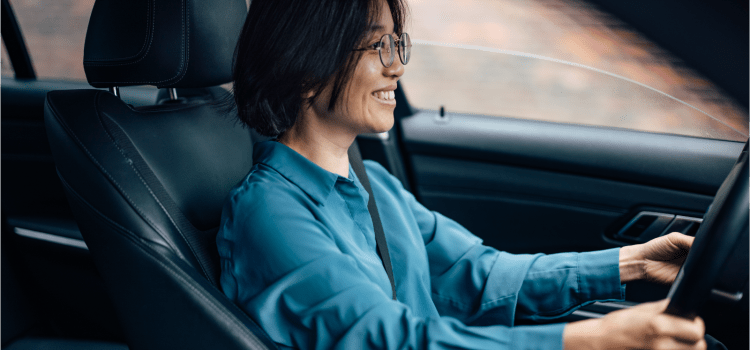As a freelancer there might be times when you need to travel for work. If you use your own vehicle to make the journey, you can claim the cost of your trip against your tax bill as an allowable business expense.
In this article we’ll go over what you can claim for, and how to work out your mileage expenses.
How much is the mileage allowance for freelancers?
Freelance sole traders can claim a mileage allowance based on what type of vehicle they use for the journey. Travel in your own car or van, for example, and you can claim 45p per mile for the first 10,000 miles of business-related travel you do during the tax year, and then 25p per mile for the rest of the tax year.
The flat rate for mileage is set by the government:
- Cars and vans: 45p for the first 10,000 miles and then 25p for any miles beyond that
- Electric cars and vans: 45p for any number of miles
- Motorcycles: 24p for any number of miles
- Bikes: 20p for any number of miles
It’s also worth noting that if you employ anybody under your own company and you’re travelling with them, you can add on an additional 5p per mile, per passenger.
This method of claiming the mileage allowance is also known as the flat rate or simplified expenses method, because it’s designed to make it easier for freelancers to work out their claim – but you can’t use simplified expenses if:
- You’re a company director travelling on company business (instead, your company will reimburse you for the expense using the mileage rates, and then claim the cost of repaying you on its Company Tax Return)
- You’re using a vehicle designed for commercial use, like a taxi or a dual control driving instructor car.
- You’ve already claimed capital allowances for the vehicle or included it as an expense
So, what happens if you’re not eligible to claim your mileage using simplified expenses, or your costs are higher than the flat rate would allow you to get back? There is another option available to you.
Claiming your actual vehicle expenses
The direct cost (also known as actual expenses) method allows you to claim the exact cost of using your own vehicle for business travel. It can be useful if you’re not able to use simplified expenses, or if the flat rate amount isn’t enough to cover the cost of your trip.
This method requires you to be far more specific because you will need to calculate, as a percentage, how much of your motoring costs were directly related to business purposes.
Once you know this percentage, you can then claim that portion of all motoring and vehicle costs incurred, which can help save you more money than if you were to just apply flat mileage rates.
Actual expensing also calls for more meticulous bookkeeping and accounting because you will need to keep a record of things like fuel receipts, vehicle repairs, servicing, breakdown cover, parking, etc.
What trips can I claim travel expenses for?
You can claim the mileage allowance (or your actual costs) for journeys where you’re:
- Travelling from one work location to another (e.g. office to office, project site to project site, etc.)
- Travelling from a temporary business-related location such as a client’s premises or an event venue. This has to be somewhere you spend less than 40% of your time or somewhere you don’t expect to visit for more than 24 months to qualify as ‘temporary’.
The main thing to remember is that you can only claim allowances for trips or vehicle usage that is 100%, exclusively for business-related purposes. Anything personal-related will need to be discounted from your allowable expenses.
There are some scenarios in which mileage allowance won’t be applicable, and you won’t be able to claim any compensation for this type of journey, whether that’s the full journey or part of a longer journey. We’ll give you a few examples below.
Example scenario 1
You are asked to travel 30 miles to attend a meeting at a client’s office. In this case, you can claim mileage allowance on the whole journey (all 30 miles) because it was exclusively for business purposes.
Example scenario 2
You are asked to travel 30 miles to attend a meeting at a client’s office. However, on the way, you decide to take a 5-mile detour to run some personal errands while you’re on the road.
In this case, you can claim for the 30 miles required for business-related travel but the 5 miles at the start of the journey will need to be discounted.
You travelled 35 miles, but only 30 were for business, so the mileage allowance will only apply to this portion of the trip.
Example scenario 3
You decide to drive to The Lake District to spend a bank holiday weekend exploring. You cannot claim any mileage allowance for this trip because no portion of the journey is business-related. These are all personal miles.
How to record and claim mileage allowance
You should record the start and end point of every journey, the date on which it took place, and what method of travel you used. It’s up to you how you keep these records, as long as they’re complete, accurate, and clear!
There are different types of mileage tracking software and apps which might help, and some bookkeeping apps even include mileage tracking features – such as Pandle and QuickBooks.
You can then claim your mileage expenses through your Self Assessment tax return, along with any other costs, by deducting your claim from the total income you make, so you only pay tax on the profits left over.
Even if you only travel occasionally for business purposes, it’s still worth calculating, recording and claiming mileage allowance because every little helps towards keeping your tax bill down.
Find even more advice and guidance for freelancers in our info hub!








[…] Car mileage […]
[…] of travel – tickets, mileage, fuel, and parking (excluding standard travel to and from […]